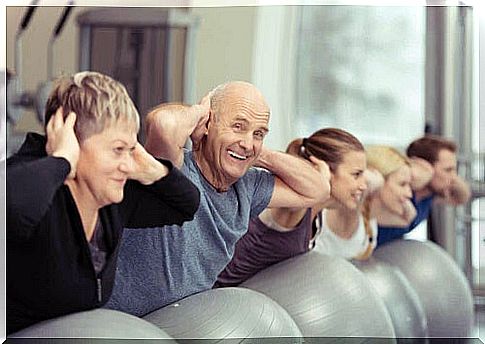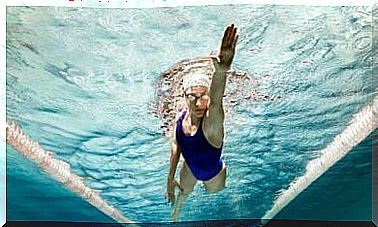Sedentary Lifestyle In Women After Retirement

Many people feel that after retirement, people are taking on a more sedentary lifestyle because they do not have to go to work or perform certain tasks related to having a job. A sedentary lifestyle in women is an issue that deserves a separate article.
In order to gather objective evidence in this regard, a medical team from the University of Turku (Finland) conducted a scientific study on the matter. The goal was to find out about the sitting time before and after retirement, comparing whether these values differ by gender and profession.
After observations carried out during the year on almost 500 participants, it was found that sedentary lifestyle intensified in women , while in men it remained at a high level.
This is something that needs special attention to increase activity in retirees. This, in turn, can help reduce the risk of diseases and disorders associated with a sedentary lifestyle.
Sedentary lifestyle in women before and after retirement
Experts define a sedentary lifestyle as the low-energy-expenditure behavior that occurs while awake, whether while sitting, lying down or resting, watching TV, listening to music, being in front of a computer, or reading.
According to various studies, the sedentary lifestyle has increased in recent decades in the world. This is due to technology related to work, home work and commuting, as well as leisure chosen by people.
A sedentary lifestyle is more common in Western countries. According to studies that report it, it tends to increase with age after retirement.

How was the study carried out?
In a 2019 study by Suors et al. Published in the journal Journals of Gerontology , the authors assumed that there was research into sedentary lifestyles, but most of them are self-reported.
This means that the respondents themselves provide information. However, the data may be unreliable, subject to modification, and informative bias as the person may not remember or say something for convenience.
To avoid such a problem, scientists turned to technological resources to make accurate as well as objective measurements. For this purpose, accelerometers were used that participants put on their wrists.
The final sample consisted of 478 people, public sector employees, retirees in 2016-2019 who previously participated in the Finnish Elderly Survey (FIREA). They were contacted prior to the expected retirement date. People who agreed to participate were supplemented with questionnaires and accelerometer measurements.
What were the results?
The data from the accelerometer were collected by the said device before and after retirement with an interval of one year. The following data stand out among the main results of the study:
- The majority were women (85%) who worked in physical occupations (67%).
- The average retirement age was 63.2 years.
- The mean waking hours were 16.1 hours before and 15.7 hours after retirement. Therefore, there has been an increase in sleep hours.
- In working life, the average sedentary lifestyle of women was 8 hours and 10 minutes a day.
- Women were less active after retirement, averaging 29 minutes of activity.
- Although sedentary time was shorter in manual workers, they showed a greater increase in inactivity after retirement (63 minutes).
- Before retirement, the daily sitting time of men was almost two hours longer than that of women. However, the men showed no change after retirement.
More sedentary lifestyles in women after retirement – the crux of the study
This is the first study to analyze changes in people’s schedules, measured objectively. The results confirm other previous results. Because it is true that sedentary lifestyle increases after retirement. However, as it turns out, this indicator is not the same for everyone.
As observed, it can be said that, on average, men are generally less active. Women, on the other hand, become more passive after retirement. Scientists suggest that measurements should be made with other groups of subjects. Moreover, they believe that the results can be manipulated. Therefore, they should be approached with a certain amount of distance.
Why should we activate in old age?
These conclusions can be seen as an alarm signal. Why? Well, the dangers associated with a sedentary lifestyle are numerous. They are associated with various health disorders, such as:
- Obesity.
- Increase in blood cholesterol.
- Weakness and loss of muscle mass (sarcopenia).
- Diabetes.
- Cardiometabolic diseases.
- Osteoarthritis and osteoporosis.
Therefore, after retirement, we need to take even more care of an active lifestyle. This will help reduce the risk of disease and complications. A sedentary lifestyle can be overcome with a little willpower. The profit is huge and every effort pays off.

How to retire actively?
To have active retirement, you need to start by reducing the number of hours you spend on inactive rest. This applies to watching TV or surfing the Internet, using a tablet, phone or computer.
On the other hand, there are various exercises for seniors that can be done at home. It should be noted that the physical activity of the elderly is adjusted in terms of exercise and load. Likewise, stretching and strengthening exercises should be adapted to different areas of the body.
It is also recommended to replace sedentary activities with other activities that require additional burning of calories. The alternative is dance classes. The benefits of dancing are diverse, both physically and socially.
Another option is to join clubs and associations. Although in some cases these activities are not very dynamic, the mere fact of having to move (preferably on foot) means getting out of the house. This, in turn, reduces a sedentary lifestyle in women and men.
Sedentary lifestyle in women after retirement – that can change
Retirement can be a difficult time. For some, even traumatic. throughout our lives we have learned to work and be always busy. But we have not been taught what to do when it comes time to be alone at home.
Most people have hobbies that relax them. This is where the hours spent at work fill in. However, many of these activities do not require physical exertion.
Consequently, as is the case at other times in life, it is time to reinvent yourself after retirement. All this to continue. Women who lead a more sedentary lifestyle after retirement can improve their well-being and quality of life with few active changes.









